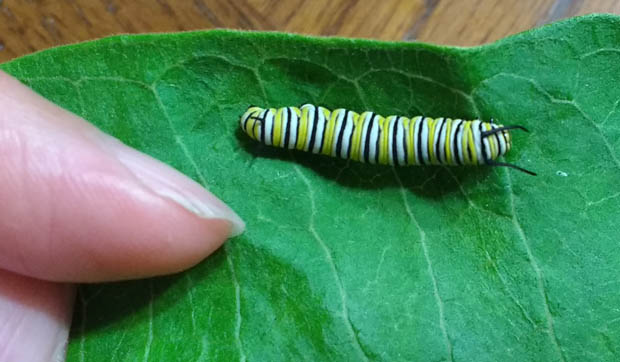Barely larger than a grain of rice when it was first discovered, this young monarch caterpillar today is inside its chrysalis and will soon emerge a monarch butterfly.
Good Natured: Nature & Yardwork
June 22, 2018
The day’s plan was pretty straightforward, or so I thought.
Get some plants in the ground, clean the gutters, scrub the deck, trim a shrub– few hours’ work followed by an afternoon of R&R seemed completely feasible, not to mention fulfilling and even fun. So why was it I was rinsing the last bits of grime off the deck at 8:30 p.m., when it was almost dark? With plants still in their pots in the garage?
It would seem those best-laid plans failed to take into account two things: Nature’s wonders, and my wondering nature. Here’s a recap:
Monarch Caterpillars! If you’ve ever seen my yard, you’ll know I’ve been encouraging milkweed to grow, in the hopes of attracting monarchs. Each year the plants grow tall and strong, the monarchs visit them, appear to deposit eggs and then…nada.
Last year I did some closer observation and discovered that the milkweeds are home not only to monarchs, but also spiders, milkweed beetles, milkweed leaf beetles, earwigs, aphids and at least three species of ants. Alas, many of these creatures eat monarch eggs and young caterpillars. I vowed from that point forward that I would be more proactive about rescuing monarch larvae.
So what was I to do the other day when I saw, not one or two, but six teensy caterpillars on the milkweed? I abandoned the gardening plans and instead set about setting up an indoor monarch-ararium. Many thanks to my wise and monarch-savvy friend Peggy who faithfully answered each of my texts-even the one that lamented my complete lack of parenting skills and the fact that a half hour into the venture I’d already managed to lose one of the babies.
With the little cats safely set up in a large jar with plenty of tender milkweed shoots, I headed back outside to continue with the yardwork. But by this point the sun was pretty intense. Not wanting to harm the young plants by planting them in such harsh conditions, I decided to switch gears and trim the Euonymus by the front door. That’s when I encountered…
The Itsy Bitsy Spider! About 3mm long, not including its itsy bitsy legs, the tiny creature scrambled for safety as I went to work with the electric hedge trimmer. Barely 30 seconds into the job, I set the tool down, got out the step ladder and set about trying to identify the spider by examining its tangled web.
Truth be told, I was hoping I’d found Frontinella communis, a bowl-and-doily spider. As its name indicates, this talented weaver creates a web that looks like a shallow bowl positioned over a wider sheet of web, or “doily.” The spider sits between these two structures and grabs its prey-typically small flies-as it lands in the bowl, then drags it down to the doily to snack on, like a proper lady at teatime.
Alas, the web lacked a doily, and the part I thought was a bowl was actually more convex. I think what I found was a member of the genus Pityohyphantes, the hammock spiders.
Hmmm, hammocks… That word reminded me that if I was ever going to get to the rest and relaxation part of my plan, I’d better get moving. I finished the trimming, moved the ladder to the deck and clambered up onto the roof. I was just about to start scooping leaves from the gutters when my attention was diverted to…
Strange Animal Sounds! This distraction comes courtesy of a text message from Peggy. She was diligently trying to get work accomplished at her own home when she heard what sounded like distress calls coming from a tree cavity in her yard.
As I read the message, I had to balance my intrigue with, well, balance. The last thing I wanted was for Peggy to have to decipher my own distress calls should I happen to tumble off the roof while texting. I readjusted my position so as to not be so close to the edge and started mentally reviewing the habits of cavity nesters in our area when, ding! Another text arrived:
“It is all okay! New info: Baby downies never shut up! I have a downy nest in my yard!!!”
As if reading my mind, Peggy added: “I would think quieter would be safer, but research shows that woodpeckers have a 60% higher success rate, til fledging, over open-nesting birds. Once out of the nest the mortality for fledged birds of any species is the same so that cavity deal is a good plan.”
Phew! Another natural history mystery solved.
The gutter-cleaning actually proceeded rather smoothly after that which was good, as daylight was running short. Safely back on ground level, I put the ladder away, mixed the deck-washing solution and started scrubbing.
From then on the marvels came fast and furious-the orb-weaving spider by the outside light, the funnel-weaving spider by the post, the ants carrying seeds, the four (yes, four!) robins nests built but abandoned on a beam below the deck. So many wonders, so little time.
Now here we are, a week later. The deck is done, the plants are in the ground, but whole new list of chores have come up. I think it’s time to make a new plan.
But wait! What’s that I see over there in that bush…?
Pam Erickson Otto is the manager of nature programs and interpretive services at the Hickory Knolls Discovery Center, a facility of the St. Charles Park District. She can be reached at 630-513-4346 or potto@stcparks.org.

